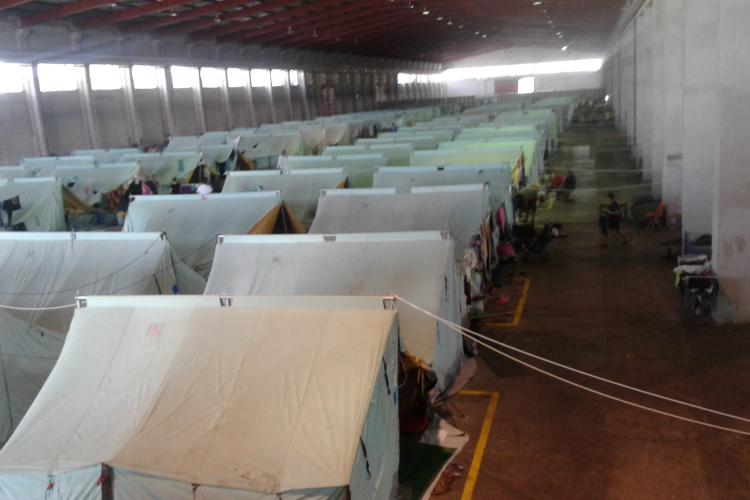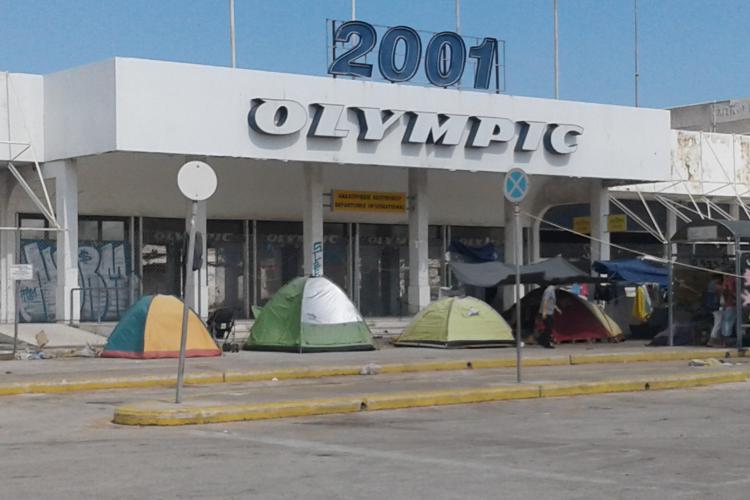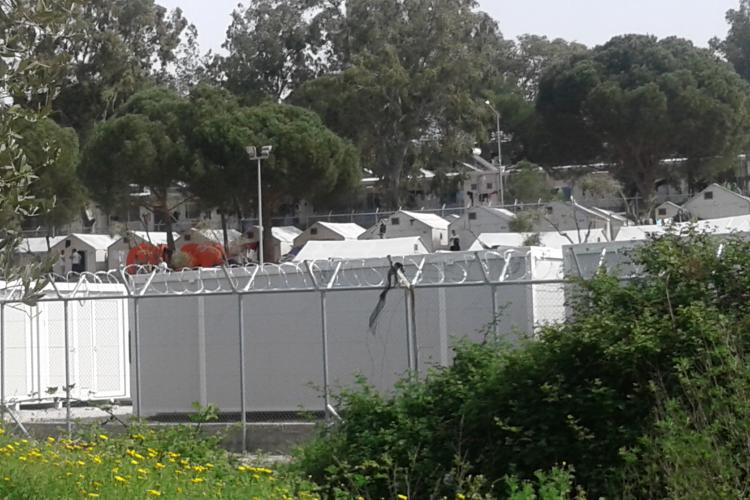Guest post by Martina Tazzioli, Lecturer in Geography at Swansea University and Visiting Lecturer in forced migration at City University of London. She is the author of Spaces of Governmentality: Autonomous Migration and the Arab Uprisings (2014), co-author with Glenda Garelli of Tunisia as a Revolutionized Space of Migration (2016), and co-editor of Foucault and the History of Our Present (2015). She is co-founder of the journal Materialifoucaultian.
Diavata refugee camp is situated seven kilometres north of the Greek city of Thessaloniki. One of the three soldiers who are guarding the main gate comes close to me, pointing to a group of Syrian guys; ‘all these people want to go to Europe, and not staying here. Yet, Europe does not allow them to pass’. As this man recognised, after the closure of the Balkan route and the EU’s demand that Greece registers all migrants, ‘Europe’ has become more distant than ever. Diavata camp, is one of fifty refugee camps in Greece that have been opened during the first months of 2016, with funding from the UNHCR and the Internal Security Fund of the European Union. More than 1500 asylum seekers, both men, women and kids, who have been evicted from Eidomeni, have been moved there. After the closure of the Greek-Macedonian border in March 2016, thousands of migrants had remained stranded in Eidomeni, until April, when the Greek government evicted them. In this blog post, I examine the logistics of the hotspot system in Greece, drawing on fieldwork I conducted in Greece in April and in July 2016, both on the mainland and on two of the islands, Lesbos and Chios, where hotspots are located. I will show that the hotspot system is formed by a web of refugee camps and transit points, institutional channels of mobility and temporal borders.

The temporal borders of migration governmentality
In Diavata, like in any other refugee camp in Greece, migrants wait. Some wait to be relocated elsewhere in Europe. Others, are simply stranded, hoping that the Macedonian border will open again or striving to find a way to cross the border. Border-zones inside the Greek territory - such as temporary refugee camps - function as hotspot-like places, dividing migrants from citizens. They also determine their 'spatial legitimacy', or, as a UNHCR officer in Thessaloniki put it, their 'geographic limitations', that is where they are allowed to go and stay. Migrants are firstly, divided on the basis of their nationality: only Syrians, Eritreans and Yemenites, and until July 1st Iraqis, could apply for relocation to another member state while their asylum case is being processed. The rest can only enter the asylum procedure in Greece. However, being eligible for relocation does not mean being effectively relocated. Indeed, more and more relocation cases have been rejected in the last two months, usually on the basis of security.
The boundaries of nationality are mobilised by national and European authorities as part of strategies of spatial containment. That is to say, on the basis of their nationality migrants are in fact moved, along institutional channels, and allocated to a certain space, while others are stranded in Greece. Yet, the logistics of the hotspots in Greece is also characterised by the multiplication of temporal borders, as a way of further restricting the access to the asylum process and to supplement other legal and spatial strategies of containment. A dense agenda of dates and time intervals determines the future geographies of migrants who landed in Greece: only those who arrived before March 20, 2016, when the EU-Turkey deal was signed, are eligible for relocation; Iraqi citizens could apply for relocation only until July 1, 2016; the pre-registration procedure for asylum seekers has been conducted between May and the end of July 2016, and it concerned only those migrants who arrived between January 1, 2015 and March 20, 2016.

Temporal borders do not only generate forms of spatial containment and increase exclusionary partitions, they also shape migrant subjectivities by multiplying differences. Syrians, for instance, are no longer depicted as refugees requiring unconditional protection; asylum claims from those who arrived after March 20th have been subjected to the clause of Turkey considered a 'safe country'. As a result, some have been sent back to Turkey.
In order to be offered a place in one of Greece’s refugee camps, migrants must pass through a pre-registration procedure that is conducted only on the mainland. Migrants are counted and, where possible identified, then placed on a waiting list for the asylum procedure. The waiting time, according to UNHCR estimations, will be about one year. Migrants can pre-register only in the relocation camps or via Skype with the Greek Asylum Service. Often the number is overloaded by calls. Those who refuse to pre-register have not been allowed to enter refugee camps and access the health services or toilets in the camps. The pre-registration procedure has functioned as a sort of migration census technique and as a disciplinary strategy. Pre-registering generates migrant population statistics and makes future asylum seekers reachable and traceable. Finally, it also served as a temporary guarantee of non-deportability: all pre-registered migrants, as future asylum applicants who expressed the will to claim asylum, could not be sent back to Turkey.
The protracted delay in claiming asylum or relocation has also constituted a leeway for migrants: becoming non-deportable they spent their time organising their journey along the Balkan route. A similar temporal leeway has been found by migrants through a sudden massive recourse to the asylum process. Confronted with accelerated channels of deportation from the Greek islands after the March 20th agreement, in the span of few days the majority of those inside the hotspot of Lesbos laid their asylum claim, becoming non-deportable. In so doing, they generated a log jam, using the spatial control usually exercised over asylum seekers as a form of guarantee against their forced removal.
Greece as a space of containment

From a space of transit, the Hellenic peninsula has become a site of containment where migrants are partitioned and divided. Similarly, many transit zones, like the Terminal 1 of Pireus port, where migrants used to stay only few hours before continuing their journeys, in few a weeks have been transformed into spaces of control, identification and indefinite wait. The concomitance of these two route closures - the Balkan corridor and the sea route from Turkey to Greece - has made relocation appear as the only possible spatial strategy for migrants to move away from Greece. Indeed, as I have been told at the headquarters of EASO in Athens, 'when the relocation started, it had been presented to migrants as a way for them to continue their journey safely; yet, the majority preferred to do that in an autonomous way. Only after realising that they were stranded in Greece with no alternatives, Syrians opted in mass for the relocation'.

The refugee City Plaza Hotel in Athens which has been hosting 400 migrants since April, represents a sort of counter-camp: neither NGOs nor governmental authorities are allowed to enter, and as a space-refuge it subverts the function of a space of containment and control that characterises hotspots and camps. At the time of writing, 60 817 women, men and children are currently stranded in Greece, while the European Union is financially supporting their protracted detention by funding the establishment of new centers. Narratively spectacularized, in the media, migrants are in the end spatially invisibilized: migration movements across Europe are disciplining and contained through a scattering and moving around strategy that consists in dividing migrant multiplicities and transferring them to different places. Most of the time, this happens through a kind of moving back game, such as migrants in Italy who are transferred by force from Ventimiglia, at the Italian-French border, to the hotspots in South of Italy, forcing them to restart their journey. 'We want to go to Europe and not to stay here' migrants commonly allow, 'but where is Europe? Is this Europe?'
Any comments about this post? Get in touch with us! Send us an email, or post a comment here or on Facebook. You can also tweet us.
Share:








